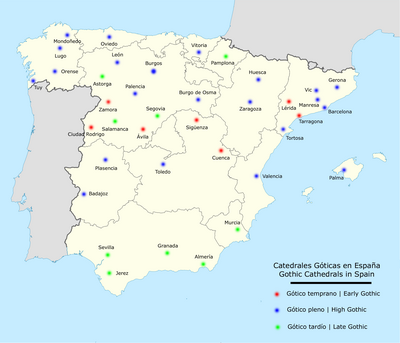Spanish Gothic architecture

Spanish Gothic architecture is the style of architecture prevalent in Spain in the Late Medieval period.
The Gothic style started in Spain as a result of Central European influence in the twelfth century when late Romanesque alternated with few expressions of pure Gothic architecture. The High Gothic arrives with all its strength via the pilgrimage route, the Way of St. James, in the thirteenth century. Some of the most pure Gothic cathedrals in Spain, closest related to the German and French Gothic, were built at this time.
In some cases the Gothic style was built and decorated with
Catholic Monarchs, that predicated a slow transition to Renaissance architecture
.
Sequence of Gothic styles in Spain

The designations of styles in Spanish Gothic architecture are as follows. Dates are approximate.
- Early Gothic (12th century)
- High Gothic (13th century)
- Mudéjar Gothic (from the 13th to the 15th centuries)
- Levantino Gothic(14th century)
- Valencian Gothic (14th and 15th century)
- Catalan Gothic
- Flamboyant/Late Gothic (15th century)
- Isabelline Gothic(15th century)
- Plateresque Gothic (15th century)
Examples
Early Gothic
- Cathedral of Ávila
- Cathedral of Cuenca
- Cathedral of Sigüenza
- Abbey of Santa María la Real de Las Huelgas in Burgos
High Gothic
- Cathedral of Burgos
- Cathedral of Burgo de Osma
- Cathedral of León
- Cathedral of Toledo
- Palace of the Kings of Navarre in Olite
- San Pablo Church, Valladolid
Mudéjar Gothic
- Cathedral of San Salvador, in Zaragoza
- Castillo de Coca in Coca
- St. Martín's Tower in Teruel
Valencian Gothic
- Valencia Cathedral
- Valencia
- Torres de Serranos
- Palace of the Borgias
- Monastery of Sant Jeroni de Cotalba, in Alfauir.
- Monastery of Santa María de la Valldigna, in Simat de la Valldigna.
- Basilica of Santa Maria, in Alicante.
- Orihuela Cathedral, in Orihuela.
- Castelló Cathedral and El Fadrí, in Castellón de la Plana
- Segorbe Cathedral in Segorbe.
Balearic Gothic
- La Seu (cathedral) of Palma de Mallorca
Catalan Gothic
- Santa Maria del Mar of Barcelona
- Barcelona Royal Shipyard
- Royal Palace in Barcelona
- Cathedral of Girona
Flamboyant/Late Gothic
- Cathedral of Oviedo
- Cathedral of Sevilla
- Cathedral of Segovia
- Chapel of the Condestable, Cathedral of Burgos
- New Cathedralin Salamanca
Isabelline Gothic
- Monastery of San Juan de los Reyes in Toledo
- Royal Chapel of Granada in Granada
- Colegio de San Gregorio in Valladolid
- Palace of Infantadoin Guadalajara
- Palace of Jabalquinto in Baeza, Jaén
- San Pablo Churchin Valladolid
Modern Spanish Gothic
Gallery
-
Church of San Miguel (Jerez de la Frontera), crossing vault
-
Iglesia de San Pedro, Teruel, nave and apse
-
Santa María de la Oliva, nave
-
Santa María de la Oliva, apse
-
Crossing vault of Seville Cathedral by Juan Gil de Hontañón
-
Monastery of Santa María de Huerta, refectory pulpit
See also
- Gothic architecture
- Romanesque architecture
- Cathedral architecture of Western Europe
- gothicmed


![Church of St John the Baptist, Ágreda [es] in Ágreda, nave](http://upload.wikimedia.org/wikipedia/commons/thumb/6/69/Iglesia_de_San_Juan_Bautista%2C_%C3%81greda%2C_Soria%2C_Espa%C3%B1a%2C_2018-03-29%2C_DD_43-45_HDR.jpg/120px-Iglesia_de_San_Juan_Bautista%2C_%C3%81greda%2C_Soria%2C_Espa%C3%B1a%2C_2018-03-29%2C_DD_43-45_HDR.jpg)
![Church of St Felix, Torralba de Ribota [es] in Torralba de Ribota, altar](http://upload.wikimedia.org/wikipedia/commons/thumb/e/e8/Iglesia_de_San_F%C3%A9lix%2C_Torralba_de_Ribota%2C_Zaragoza%2C_Espa%C3%B1a%2C_2018-04-04%2C_DD_24-26_HDR.jpg/120px-Iglesia_de_San_F%C3%A9lix%2C_Torralba_de_Ribota%2C_Zaragoza%2C_Espa%C3%B1a%2C_2018-04-04%2C_DD_24-26_HDR.jpg)
![Church of St Felix, Torralba de Ribota [es] in Torralba de Ribota, portal](http://upload.wikimedia.org/wikipedia/commons/thumb/f/f4/Iglesia_de_San_F%C3%A9lix%2C_Torralba_de_Ribota%2C_Zaragoza%2C_Espa%C3%B1a%2C_2018-04-04%2C_DD_51-53_HDR.jpg/120px-Iglesia_de_San_F%C3%A9lix%2C_Torralba_de_Ribota%2C_Zaragoza%2C_Espa%C3%B1a%2C_2018-04-04%2C_DD_51-53_HDR.jpg)










